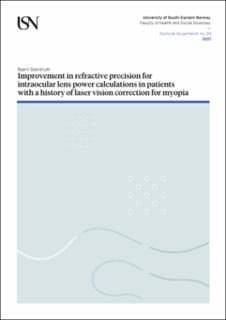Improvement in refractive precision for intraocular lens power calculations in patients with a history of laser vision correction for myopia
Doctoral thesis
Published version
Permanent lenke
https://hdl.handle.net/11250/2756351Utgivelsesdato
2021-05-28Metadata
Vis full innførselSamlinger
Sammendrag
In Cataract surgery and refractive lens exchange (RLE) planning, calculations of intraocular lens (IOL) power depend on, at a minimum, the measurement of corneal curvature and the axial length of the eye. In patients without prior refractive surgery, the accuracy of the procedure is high. However, for patients who have previously undergone laser vision correction (LVC) the precision is much lower because calculations based on empiric formulas does not account for the individual altered shape in these patients’ corneas. Erroneous keratometric measurement due to unstable tear film may be an additional confounding factor. The aim of this thesis was to improve refractive precision for cataract or RLE in patients with previous LVC for myopia by applying exact calculations based true individual measurements of the patient’s eyes, and thus reduce the risk of ecological fallacy.
A retrospective analysis of postoperative refractive results and recalculated IOL power with optimized lens constants and target nomograms was conducted to assess possible improvement in traditional formula-based calculations. Thereafter, a cross-sectional casecontrol study was performed comparing signs and symptoms of dry eye disease in patients with a history of LVC to a control group. In the next study, repeatability of different keratometers was compared in patients with hyperosmolar and normal tears. Finally, a prospective interventional single-arm study was conducted to compare traditional IOL calculations with individual ray tracing calculations in cataract and RLE patients who had previously undergone myopic LVC.
Results from the retrospective study indicated that a refined protocol could improve traditional formula based IOL calculations in patients with previous myopic LVC. However, using ray-tracing calculation based on OCT measurements of the anterior segment of the eye could yield similar or even better results. Ray tracing methods does not require analysis of previous results, and thus, is more applicable in any clinic. Furthermore the method does not require knowledge of a patients previous LVC treatment and can yield accurate results also for patients without previous refractive surgery. In the prevalence study, osmolarity results indicated higher risk of DED in previous LVC patients compared to a control group. However, there was no evidence that repeatability of keratometry was influenced by osmolarity.
Består av
Paper 1: Brenner, L.F., Gjerdrum, B., Aakre, B.M., Lundmark, P.O. & Nistad, K.: Presbyopic refractive lens exchange with trifocal intraocular lens implantation after corneal laser vision correction: Refractive results and biometry analysis. Journal of Cataract and Refractive Surgery 45(10), (2019), 1404-1415. https://doi.org/10.1016/j.jcrs.2019.05.031. Not available onlinePaper 2: Gjerdrum, B., Gundersen, K.G., Lundmark, P.O., Potvin, R. & Aakre, B.M.: Prevalence of signs and symptoms of dry eye disease 5 to 15 years after refractive surgery. Clinical Ophthalmology 14, (2020), 269-279. https://doi.org/10.2147/OPTH.S236749
Paper 3: Gjerdrum, B., Gundersen, K.G., Lundmark, P.O. & Aakre, B.M.: Repeatability of OCT-Based versus Scheimpflug- and Reflection-Based Kerat. Clinical Ophthalmology 14, (2020), 3991-4003. https://doi.org/10.2147/OPTH.S280868
Paper 4: Gjerdrum, B., Gundersen, K.G., Lundmark, P.O. & Aakre, B.M.: Refractive Precision of Ray Tracing IOL Calculations Based on OCT Data versus Traditional IOL Calculation Formulas Based on Reflectometry in Patients with a History of Laser Vision Correction for Myopia. Clinical Ophthalmology 15, (2021), 845-857. https://doi.org/10.2147/OPTH.S298007

